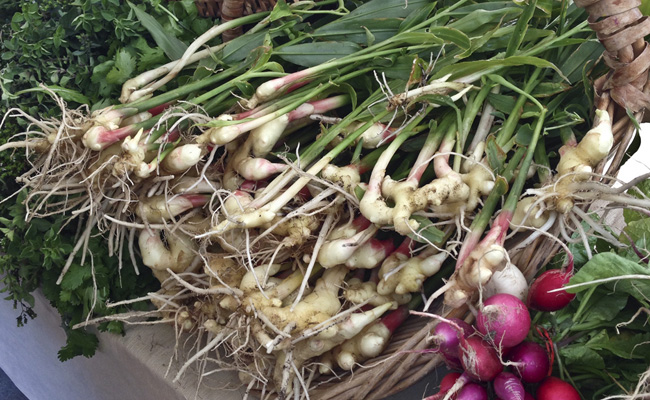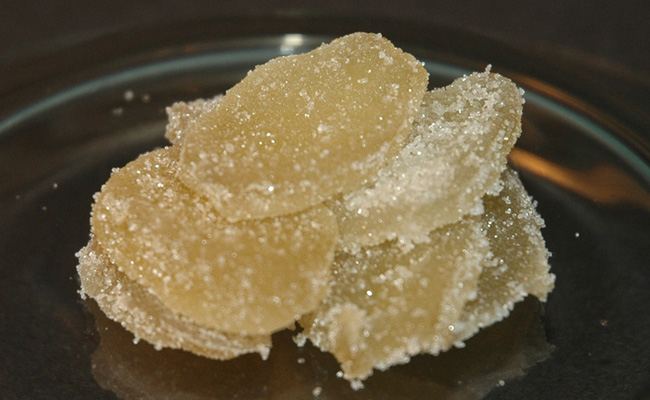
It’s almost October and the farmers markets are beginning to wind down. Zucchini and tomatoes are on the wane. Who would expect to see a vibrant, new food at the stands of three producers at the Mill City Farmers Market?
Meet fresh ginger in all its fragrant, magenta-tinged glory. This ginger is tender, virtually without fibers, and very hot. You can find it at the Stone’s Throw and Seven Songs booths for the next few weeks ($15-$16/lb), and Stone’s Throw expects to have enough to sell at the Mill City indoor markets this winter.

Melissa Driscoll of Seven Songs Farm in Kenyon, MN (above) is the pioneer of local ginger. She first learned that the spicy rhizome could be a cold-climate crop in 2011, while reading Growing for Market, a magazine she swears by. The article was written by the owners of Old Friends Farm in Amherst, Mass. It detailed the successful growing method they devised with the help of a Federal Sustainable Agriculture Research and Education (SARE) grant.
This is Seven Songs’ third year growing ginger, but their first year selling it at Mill City.
Driscoll explains that growing ginger in the Upper Midwest is not easy. Even receiving the seed is a challenge. Seed ginger is shipped from Hawaii or North Carolina in February. It has to be specially packaged because it can’t survive at temperatures below 50°F. Any ginger can be broken into pieces and sprouted, but as with potatoes, having stock that is certified to be disease free gives the farmer greater certainty of success.

When the ginger arrives, Driscoll plants it in a mixture of peat moss and straw and lets it sprout in a closet that is warmed to a temperature of 80°F. Next she transfers the plants to flats and sets these on a heating mat by a window. In mid-May, the flats are moved to a hoop house. Ginger is a heavy feeder and needs good soil and lots of fertilizer. Driscoll mounds more soil around the ginger as it grows to encourage the roots to enlarge and spread.
Next year, in addition to yellow ginger, Driscoll hopes to grow blue ginger, which she will source from Biker Dude in Hawaii, whose owner has “ORGANIC YELLOW GINGER” tattooed on his chest in large, ornate letters.
Alex Liebman of Stone’s Throw Urban Farm in Minneapolis came to ginger after winning a grant from the Mill City Farmers Market aimed at expanding the variety of fruits and vegetables available for sale.
Liebman points out that ginger is actually a biennial and would normally be harvested in its second year, when the rhizome is large. In Minnesota, though, it doesn’t make sense to overwinter a plant that is even more sensitive to cold than tomatoes, so the best a farmer can do is extend the growing season. Liebman started his plants in mid-April in a greenhouse and put them outside in May. He’s still experimenting with optimal timing, but plans to start sprouting in March next year and let the plants grow in the greenhouse for two months.

Stone’s Throw will be planting turmeric for the first time this winter. Growing new things “makes farming exciting,” Liebman says. “If we’re going to eat locally we can’t eat kale from September to September.” Ginger is one of the crops that provides variety.
The third Mill City ginger grower, Seed to Seed Farm in Clear Lake, WI, is done for the season. The farmer, Ariel Pressman, was inspired to grow ginger when he saw Seven Songs’s ginger at the Seward Co-op in Minneapolis. He says ginger is fun to grow and “chefs go nuts for it.” Pressman sprouts his seed ginger in soil and plants it outside after the tomatoes are in. He uses infrared-transmitting plastic mulch to keep the soil warm and moist. Small holes are punched in the plastic, and the ginger seedlings are planted in the soil beneath. Next year Pressman plans to grow more ginger as well as artichokes and purple Brussels sprouts. There’s a “world of flavors and genetic diversity” waiting to be discovered, he says.
Below are two ways to use fresh, local ginger. The syrup left over from making crystallized ginger can be used to make a delicious caramel sauce with a nice, hot finish.

Crystallized Ginger
Yield: ½ to ¾ lbs candied ginger
½ to ¾ lb young, fresh ginger root, weighed after stems have been removed as in Step 1 (see note for supermarket ginger)
2½ c granulated sugar
2½ c water
1. Cut stems, leaves and any dried or discolored parts from ginger root. you may retain the first inch or two of the stem, where it is still pink, but be sure to peel away several layers, exposing the white center. Scrape skin from the root. There will be just a thin layer of skin that can be rubbed off with the edge of a teaspoon.
2. Slice the root horizontally (across the fibers) ⅛″ thick, or slightly thicker. If the root is small, you may slice it diagonally to get larger-diameter pieces. Peeled stems may be sliced in half lengthwise.
3. Put ginger in a 2½- to 3-quart pot, and cover generously with cold water. Bring to a boil and boil for five minutes. Drain ginger; return to pot; cover with fresh cold water; and boil again for five minutes. Repeat once more, for a total of three parboils. This process softens the ginger and allows it to absorb the sugar syrup more evenly. It also removes any bitterness.
4. Return ginger to the pot and add 2½ cups sugar and 2½ cups of water. Heat, stirring occasionally, until sugar is dissolved. Bring to a boil, and let the mixture cook at medium heat until it reaches 222°F on a candy or instant-read thermometer. This may take an hour.
5. Remove from heat and let sit for 1 to 3 hours. Pour into a large sieve, collecting the syrup in a bowl for later use. When the ginger has drained, spread it out on a piece of parchment or wax paper. Let the ginger dry for 2 to 8 hours. At this point, the surface may feel dry to the touch. If so, separate the pieces, and the ginger is ready to use. If the surface is still tacky, toss the ginger with some additional granulated sugar. Store ginger in a jar or heavy plastic bag in the refrigerator. It will keep for many months. The syrup can be used to flavor yogurt or drinks or to make ginger caramel sauce.
Note: if using older, supermarket ginger, peel the brown skin completely. This can be done with the edge of a spoon or a vegetable peeler. Slice the ginger very thinly.

Ginger Caramel Sauce
Yield: 1⅓ cups
The syrup left over from making crystallized ginger, approximately 1 cup but the exact measurement is not important
1 c heavy whipping cream
1 tbsp unsalted butter
Sea salt, optional
1. Heat the cream slowly in a small pan while making the caramel in step 2. When it simmers, turn off the burner. Rewarm the cream briefly when the caramel starts to color.
2. In a small, heavy 1- to 2-quart pot, Bring the syrup to a boil, swirling the pan to melt any sugar crystals. As the syrup boils, it will produce a sponge of thick white bubbles. When the bubbles begin to color, which could take about 10 minutes, watch the mixture carefully, and remove from the heat as soon as it turns a medium-dark amber. It will continue to color in the pot, and it is important to stop the cooking before the caramel turns brown and burns.
3. Immediately put the pot with the caramel in a sink, and pour in the cream. Be careful: The mixture will bubble up and may spatter. It will continue to bubble for a minute or so. Stirring during this time will cause the mixture to bubble furiously and possibly overflow. The caramel will harden somewhat. When the bubbling stops, return the pot to the stove, and heat, stirring, until the caramel has melted completely into the cream. Remove from heat and stir in the butter. If you are a fan of salted caramel, add sea salt to taste.

They may already be here if what I saw at my grocery store in North Branch yesterday was true. There was a big stand-alone table with nothing on it but pineapples and MN Grown sign!!
Thank You for the this great article Jane! Its so good to know that ginger is growing in Minnesota.. and the recipes are an added bonus! Ginger caramel sauce by a warm fire sounds delicious on a cold Midwestern winter.
I’m interested in growing ginger for myself, for use in a product called super tonic. Can u contact me via email or phone 320-305-9196
Three years ago in my MN home I started a pineapple from the top of a grocery store pineapple. In January (2017) it started to blossom and now in May it is about 3/4 the size of a full pineapple. At the same time the parasol plant I’ve had for nearly 20 years decided to bloom. I keep both in pots, put them outside in the summer and bring them inside for the winter. Although one pineapple doesn’t make me a farmer, I can appreciate Liebman’s statement, ‘Growing new things makes farming exciting.’